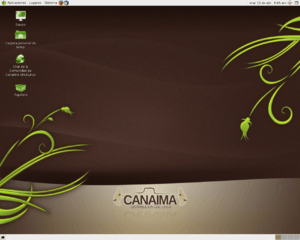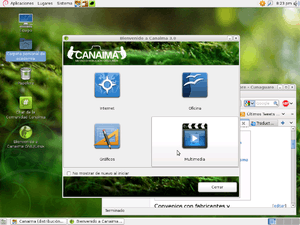Canaima (operating system)
|
Canaima Popular 3.0 (Roraima) | |
| Developer | CANTV / CNTI / CENTIDEL / Edelca / VIT / FUNDACITE / Free software community |
|---|---|
| OS family | Unix-like |
| Working state | Current |
| Source model | Open source |
| Initial release | 18 October 2007 |
| Latest release | 5.0 Chimantá / 19 December 2016[1] |
| Available in | Venezuelan Spanish |
| Update method | APT (several front-ends available) |
| Package manager | dpkg |
| Platforms | IA-32, x86-64 |
| Kernel type | Monolithic (Linux kernel) |
| Userland | GNU |
| Default user interface | Cinnamon and MATE[1] |
| License |
Free software licenses (mainly GPL) |
| Official website |
canaima |
Canaima GNU/Linux is a computer operating system based on Debian. It originated as a solution to cover the needs of the Venezuelan Government as a response to presidential decree 3,390 that prioritizes the use of free technologies in the public administration. On March 14, 2011, Canaima was officially established as the default operating system for the Venezuelan public administration.[2]
The operating system has gained a strong foothold and is one of the most used Linux distributions in Venezuela, largely because of its incorporation in public schools.[3][4] It is being used in large scale projects as "Canaima Educativo", a project aimed at providing school children with a basic laptop computer with educational software.[5] nicknamed Magallanes. Use of Canaima has been presented on international congresses about the use of open standards,[6] Despite being a young development, it has been used on the Festival Latinoamericano de Instalación de Software Libre (FLISOL).[7]
In February 2013 DistroWatch ranked it the 185th most popular Linux distribution among 319 for the last 12 months.[8] Official Venezuelan news outlets report several installations, but the majority of computers in the country still run pirated versions of Microsoft Windows, unless Windows is preinstalled with new computers.
Features
Some of the major features of Canaima GNU/Linux are:
- Easy installation
- Software license cost is free.
- Free distribution and use.

The Free Software Foundation (FSF) states that Canaima GNU/Linux is not 100% free software. This is because of the fact that some of its components are closed-source proprietary software, in particular some hardware drivers needed for graphic cards, sound cards, printers, etc. Canaima creators opted to include these proprietary drivers in order to support as many computers being used by the Venezuelan government as possible, and to facilitate the migration from a closed-sourced operating system to an open-source one. It is expected that Canaima, in its upcoming releases, offers an option in the installation process for proprietary drivers to be optional, being able to install a 100% free software image of the distribution if the user choose to.
Included Software
Canaima includes applications for training, development and system configuration. The Graphical User Interface (GUI) and desktop environment by default is GNOME. There are other desktop environments and GUIs maintained by the community for the system, like Xfce.
Productivity: The office software suite LibreOffice, with word processor, spreadsheet, presentation program, it includes other more specific programs like project management software Planner and a HTML editor.

Internet: Includes the Cunaguaro browser, a web browser based on Iceweasel and adapted especially for Canaima 3.0 and onwards. Canaima Curiara, is a light web browser based on Cunaguaro, developed in python-webkit for specific applications on the distribution.
Graphics: Includes Gimp, Inkscape, desktop publishing software Scribus and gLabels labels designer.
The full list of included software can be found at here.
Releases
Canaima has been releasing stable versions periodically since the last couple of years.[9]
| Version | Codename | Release date |
|---|---|---|
| 1.0 | Canaima | 2007-10-18 |
| 2.0 | Canaima | 2009-02-05[10] |
| 2.0.1 RC1 | Canaima | 2009-04-16[11] |
| 2.0.1 | Canaima | 2009-05-15[12] |
| 2.0.2 | Canaima | 2009-05-22 |
| 2.0.3 | Canaima | 2009-07-03[13] |
| 2.0.4 | Canaima | 2009-10-17 |
| 2.1 RC | Canaima | 2010-05-21[14] |
| 3.0 RC | Roraima | 2011-02-10[15] |
| 3.0 RC2 | Roraima | 2011-02-22[16] |
| 3.0 | Roraima | 2011-05-05 |
| 3.1 VC1 | Auyantepui | 2011-12-29[17] |
| 3.1 VC2 | Auyantepui | 2012-07-06[18] |
| 3.1 VC3 | Auyantepui | 2012-07-18[19] |
| 3.1 | Auyantepui | 2012-11-14[20] |
| 4.0 | Kerepakupai | 2013-12-04[21] |
| 4.1 | Kukenán | 2014-09-04[22] |
| 5.0 | Chimantá | 2016-12-19[23] |
| Color | Significance | |
| Red | Old version. | |
| Yellow | Older version, still supported. | |
| Green | Latest version. | |
| Blue | Future release. | |
Development Cycle
Canaima uses a development model based on Debian, but some modifications were made to adapt it to Venezuelan needs. Therefore, the development cycle has the following components:
- Socio-productive community: integrated by the Free Software Community, entities of the public administration, organized collectives and universities.
- Tools for the support of the communities composed by:
- A forge based on FusionForge located at http://forja.softwarelibre.gob.ve
- A tool for project management and bug tracking based on Trac located at http://proyectos.canaima.softwarelibre.gob.ve
- Consolidation and automated testing phase: which are based on software quality testing and evaluation criterion. This stage has an extensive use of Debian tools such as pbuilder,[24] elida in the infrastructure upon which rests.[25]
- Certification phase: in which a committee of community members proceed to make tests of functionality, check statistics, etc., in order to release a stable version.
Cayapa Canaima
One of the community activities that has been generated around Canaima is the Cayapa. Cayapa is a Venezuelan term that stands as a form of cooperative work made by several people to reach one goal.[26] On these meetings, free software developers get together to propose upgrades and fix bugs among other things; this activity is called a Bug Squash Party in other projects. The last Cayapa was conducted from May 14 until May 15, 2012 in the city of Barinas.[27]
OEMs
Being a distribution promoted by the Venezuelan Government, a certain number of strategic agreements have been generated with several countries and manufacturing hardware companies:
- Portugal: Agreement for the manufacturing of 250,000 "Magalhães" computers to be distributed on public schools
- Sun Microsystems: for the certification of Canaima devices from this manufacturer.[28]
- VIT, C.A.: Venezolana de Industria Tecnológica, mixed-enterprise between the Venezuelan state and Chinese entrepreneurs in which it established the use of Canaima on the devices that are manufactured.[29]
- Lenovo: For the certification of devices from the manufacturer for the use of Canaima.[30]
- Siragon, C.A.: Venezuelan manufacturer of computer equipment, an agreement from which Canaima is certified for use on their devices.[31]
Use of Canaima
The most successful instances of the use and adoption of Canaima:
Canaima Educativo
It is a project initiated in 2009 by the Venezuelan Ministry of Education (Ministerio del Poder Popular para la Educación) that provides students in primary education with a laptop computer, known as Canaimitas, with free software, using the Canaima operating system and a series of educational content created by the Ministry of Education.[32]
In 2011, 1,314,091 laptops were acknowledged as being delivered.[33]
CANTV
The national telephone company, CANTV, uses the operating system to a certain extent according to their Equipped Internet Plan.
Variants
There are a number of Canaima editions, maintained and recognized by community activists,[34] that are not released at the same time as the official distribution and do not take part in the project schedule. The most significant ones are:
- Canaima Colibri, a Venezuelan distribution with the goals of being friendly, light and functional for computers with low resources.
- Canaima Comunal, the idea behind this edition is that it can be extended by community councils, a form of community government called "Consejos Comunales". The main aim is to deliver an operating system to the people in these councils for their everyday work, including tools for surveys among others.
- Canaima Caribay, aimed at community media that has flourished because of government support, since the Venezuelan government sees most private media outlets as being heavily biased.
- GeoCanaima contains free Geomatics applications and data to perform various practices and interact with desktop applications, web servers and mapping generators.
- Canaima Forense, a new user-friendly environment containing a variety of useful tools for computer forensics.
See also
External links
| Wikimedia Commons has media related to Canaima. |
- Official Canaima website
- Decree 3.390
- VIT computers preloaded with Canaima
- DistroWatch popularity rankings
- Canaima at DistroWatch
References
- 1 2 "Disponible versión estable de Canaima GNU/Linux 5.0 "Chimantá"". MPPCTI. Retrieved 2017-01-10.
- ↑ "Canaima GNU/Linux". DistroWatch.com.
- ↑ http://www.rnv.gov.ve/noticias/index.php?act=ST&f=19&t=106420&hl=canaima&s=5f203b6ca55b49bfbbdb85019efce5f7 Use of Canaima in schools
- ↑ "Canaima cambios recientes". Retrieved 2013-11-25.
- ↑ http://www.cnti.gob.ve/index.php?option=com_content&view=article&id=778:portugal-enviara-250-mil-computadoras-portatiles-a-venezuela-en-el-ano-2009&catid=44:nacionales&Itemid=88 Portugal to send 250,000 laptops to Venezuela in the year 2009
- ↑ http://www.rnv.gov.ve/noticias/index.php?act=ST&f=14&t=106285&hl=canaima&s=5f203b6ca55b49bfbbdb85019efce5f7%5B%5D Venezuela participates on II Congreso Internacional Software Libre
- ↑ http://www.rnv.gov.ve/noticias/index.php?act=ST&f=14&t=95808&hl=canaima&s=5f203b6ca55b49bfbbdb85019efce5f7%5B%5D Free installation of free software in over 200 cities of Latin-America
- ↑ "DistroWatch Page Hit Ranking". Distrowatch. Retrieved 2013-11-25.
- ↑ Equipo Canaima GNU/Linux, CNTI (2012-11-17). "Evolución de Canaima en Distrowatch" (in Spanish). Retrieved 2013-02-26.
- ↑ Equipo Canaima GNU/Linux, CNTI (2009-02-05). "Liberada Canaima Popular versión 2.0" (in Spanish). Retrieved 2013-02-26.
- ↑ Equipo Canaima GNU/Linux, CNTI (2009-04-16). "Development Release: Canaima GNU/Linux 2.0.1 RC1 (DistroWatch.com News)" (in Spanish). Retrieved 2013-02-26.
- ↑ Equipo Canaima GNU/Linux, CNTI (2009-05-15). "Lanzamiento de Canaima versión 2.0.1" (in Spanish). Retrieved 2013-02-26.
- ↑ Equipo Canaima GNU/Linux, CNTI (2009-05-15). "Lanzamiento oficial de Canaima versión 2.0.3" (in Spanish). Retrieved 2013-02-26.
- ↑ Equipo Canaima GNU/Linux, CNTI (2010-05-21). "Lanzamiento de Canaima versión 2.1 RC" (in Spanish). Retrieved 2013-02-26.
- ↑ Equipo Canaima GNU/Linux, CNTI (2011-02-10). "Lanzamiento de la Primera Versión Candidata para Canaima 3.0" (in Spanish). Retrieved 2013-02-26.
- ↑ Equipo Canaima GNU/Linux, CNTI (2011-02-22). "Anunciamos la disponibilidad de la Segunda Versión Candidata (VC2) de Canaima 3.0" (in Spanish). Retrieved 2013-02-26.
- ↑ Equipo Canaima GNU/Linux, CNTI (2011-12-29). "Primera Versión Candidata de Canaima Popular 3.1 (auyantepui)" (in Spanish). Retrieved 2013-02-26.
- ↑ Equipo Canaima GNU/Linux, CNTI (2012-07-06). "Presentamos la Segunda Versión Candidata de Canaima Popular 3.1, nombre código "Auyantepui"" (in Spanish). Retrieved 2013-02-26.
- ↑ Equipo Canaima GNU/Linux, CNTI (2012-07-18). "Actualiza a la Tercera Versión Candidata de Canaima Popular" (in Spanish). Retrieved 2013-02-26.
- ↑ Equipo Canaima GNU/Linux, CNTI (2012-11-14). "Lanzamiento oficial de la nueva versión estable del Sistema Canaima GNU/Linux 3.1. Nombre código "Auyantepuy"" (in Spanish). Retrieved 2013-02-26.
- ↑ Equipo Canaima GNU/Linux, CNTI (2013-01-14). "Inició el Ciclo de Desarrollo de Canaima 4.0 "Kerepakupai"" (in Spanish). Retrieved 2013-02-26.
- ↑ Equipo Canaima GNU/Linux, CNTI (2014-09-14). "Canaima Popular 4.1 (04/09/2014)" (in Spanish). Retrieved 2017-07-22.
- ↑ Equipo Canaima GNU/Linux, CNTI (2016-12-19). "Canaima Poder Público 5.0 (19/12/2014)" (in Spanish). Retrieved 2017-07-22.
- ↑ Anibal Monsalve Salazar (2005-09-10). "Que es pbuilder" (in Spanish). Retrieved 2013-02-26.
- ↑ Lucas Nussbaum. "Use of Grid Computing for Debian Quality Assurance" (PDF). Retrieved 2013-02-26.
- ↑ http://lema.rae.es/drae/?val=cayapa Definición de Cayapa, apartado No. 5
- ↑ "6ta Cayapa Canaima: Barinas 2012". Cayapa Canaima. Archived from the original on 16 November 2012.
- ↑ CENTRO NACIONAL DE TECNOLOGÍAS DE INFORMACIÓN (CNTI) (2008-11-18). "CONVENIO MARCO DE COOPERACIÓN TECNOLÓGICA CNTI- SUN MICROSYSTEMS DE VENEZUELA, S.A." (PDF) (in Spanish). Retrieved 2013-02-26.
- ↑ CENTRO NACIONAL DE TECNOLOGÍAS DE INFORMACIÓN (CNTI) (2008-07-15). "CONVENIO MARCO DE COOPERACIÓN TECNOLÓGICA CNTI-VIT" (PDF) (in Spanish). Retrieved 2013-02-26.
- ↑ CENTRO NACIONAL DE TECNOLOGÍAS DE INFORMACIÓN (CNTI) (2008-07-15). "CONVENIO MARCO DE COOPERACIÓN TECNOLÓGICA CNTI-LENOVO" (PDF) (in Spanish). Retrieved 2013-02-26.
- ↑ CENTRO NACIONAL DE TECNOLOGÍAS DE INFORMACIÓN (CNTI) (2008-11-17). "CONVENIO MARCO DE COOPERACIÓN TECNOLÓGICA CNTI-MICROINTEGRADORA DE VENEZUELA, C.A." (PDF) (in Spanish). Retrieved 2013-02-26.
- ↑ "Venezuela: Presentan proyecto "Canaima Educativo"". Retrieved 2012-02-02.
- ↑ "Más de un millón 300 mil Canaimitas se han entregado a niños de educación básica". Retrieved 2012-02-02.
- ↑ colaboradores de la Enciclopedia Colaborativa de la Comunidad Canaima. "Sabores de Canaima" (in Spanish). Retrieved 2013-02-26.
